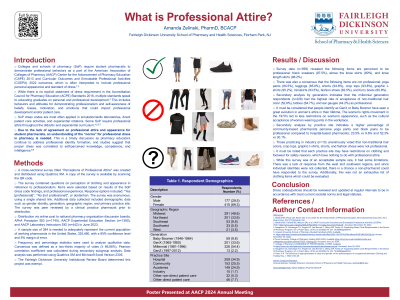Pharmacy Practice
(150) What is “Professional Attire”?


Amanda Zelinski, PharmD, BCACP
Clinical Associate Professor
Fairleigh Dickinson University
Bedminster, New Jersey, United States
Primary Author(s)
Objective : Assess perceptions of professional attire in the current pharmacy workforce.
Methods: A cross-sectional survey titled “Perceptions of Professional Attire” was created and distributed using Qualtrics XM. The survey contained stock images of clothing and other personal appearance items, with text descriptors. Respondent options included: “Yes [professional]”, “No [not professional]”, or abstention. The survey was anonymous, using a single sharable link. Additional data collected included demographics such as gender identity, generation, geographic region, and primary practice site. This survey was peer reviewed by a clinical practice pharmacist prior to distribution. A sample size of 384 was needed to adequately represent the current population of working pharmacists in the United States (325,480 persons) with a 95% confidence level and 5% margin of error. Frequency and percentage statistics were used to analyze qualitative data. Consensus was defined as a two-thirds majority of votes (≥ 66.66%). Pearson correlation coefficient was calculated during secondary subgroup analysis.
Results: Survey was distributed and remained open from June to July 2023, yielding 623 responses. Results show consensus that the following items are professional: black sneakers, above the knee skirts, and knee length skirts. There was also a consensus that the following items are not professional: yoga pants, leggings, shorts, crop tops, graphic t-shirts, miniskirts, fashion shoes, and furry boots. Sub-group analysis indicates that respondents from the millennial generation is more accepting of non-traditional hair color, tattoos, and body modification compared to other generations. Those practicing in industry (n=10) unanimously voted that non-traditional hair colors, crop tops, graphic t-shirts, shorts, and fashion shoes were not professional.
Conclusions: Dress codes should be reviewed and updated at regular intervals to reflect societal norms.
Methods: A cross-sectional survey titled “Perceptions of Professional Attire” was created and distributed using Qualtrics XM. The survey contained stock images of clothing and other personal appearance items, with text descriptors. Respondent options included: “Yes [professional]”, “No [not professional]”, or abstention. The survey was anonymous, using a single sharable link. Additional data collected included demographics such as gender identity, generation, geographic region, and primary practice site. This survey was peer reviewed by a clinical practice pharmacist prior to distribution. A sample size of 384 was needed to adequately represent the current population of working pharmacists in the United States (325,480 persons) with a 95% confidence level and 5% margin of error. Frequency and percentage statistics were used to analyze qualitative data. Consensus was defined as a two-thirds majority of votes (≥ 66.66%). Pearson correlation coefficient was calculated during secondary subgroup analysis.
Results: Survey was distributed and remained open from June to July 2023, yielding 623 responses. Results show consensus that the following items are professional: black sneakers, above the knee skirts, and knee length skirts. There was also a consensus that the following items are not professional: yoga pants, leggings, shorts, crop tops, graphic t-shirts, miniskirts, fashion shoes, and furry boots. Sub-group analysis indicates that respondents from the millennial generation is more accepting of non-traditional hair color, tattoos, and body modification compared to other generations. Those practicing in industry (n=10) unanimously voted that non-traditional hair colors, crop tops, graphic t-shirts, shorts, and fashion shoes were not professional.
Conclusions: Dress codes should be reviewed and updated at regular intervals to reflect societal norms.

.png)